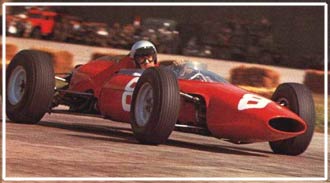 1964 The first year the Austrian Grand Prix was a part of the World Championship saw a military airfield used, the circuit laid out with haybales at Zeltweg, not far from today's A-1 Ring. Amidst mechanical carnage, Lorenzo Bandini stepped through the chaos to win his only Grand Prix victory in the Ferrari 156. Today that airfield is now used at GP time as a car park for Formula One's LearJets and Gulfstreams.
1964 The first year the Austrian Grand Prix was a part of the World Championship saw a military airfield used, the circuit laid out with haybales at Zeltweg, not far from today's A-1 Ring. Amidst mechanical carnage, Lorenzo Bandini stepped through the chaos to win his only Grand Prix victory in the Ferrari 156. Today that airfield is now used at GP time as a car park for Formula One's LearJets and Gulfstreams.

1970 The World Championship did not return until 1970, and then at the majestic sweeps of the Osterreichring. A challenging and narrow circuit of high speed sweepers and off camber corners. A circuit for the brave. Jacky Ickx is depicted here on his way to victory for the Scuderia in the Ferrari 312B. The crowd turned up to see local hero Jochen Rindt, whose engine cried enough after 21 laps. Three weeks later, the brave Austrian was dead at Monza. Ickx would be unable to bridge the points gap Rindt had built up, making Rindt, sadly, the only posthumous World Champion.
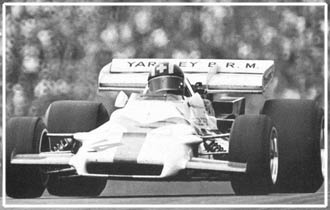 1971 A popular win for Jo Siffert in the BRM P160. BRM is a name not often associated with the commerical era of F1, the name conjuring images of Graham Hill and Jackie Stewart in the 60s, or the disaster of the early 50s collaborative industry car. BRM however continued in the winners' circle until 1972, before gradually fading from the scene.
1971 A popular win for Jo Siffert in the BRM P160. BRM is a name not often associated with the commerical era of F1, the name conjuring images of Graham Hill and Jackie Stewart in the 60s, or the disaster of the early 50s collaborative industry car. BRM however continued in the winners' circle until 1972, before gradually fading from the scene.
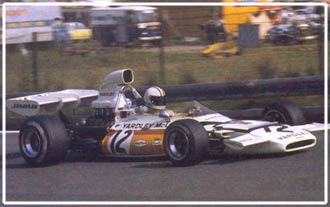 1972 Seven years after his world championship, Denny Hulme was still a force to be reckoned with. Here aboard the McLaren M19C Ford-Cosworth, Hulme was just over a second behind the winner, Emerson Fittipaldi (Lotus 72D Ford-Cosworth), at the finish. There were still years left in 'The Bear', continuing for another two years in Formula One with the team founded by his friend and countryman. Hulme would die behind the wheel of a touring car twenty years after this image of Austria was captured.
1972 Seven years after his world championship, Denny Hulme was still a force to be reckoned with. Here aboard the McLaren M19C Ford-Cosworth, Hulme was just over a second behind the winner, Emerson Fittipaldi (Lotus 72D Ford-Cosworth), at the finish. There were still years left in 'The Bear', continuing for another two years in Formula One with the team founded by his friend and countryman. Hulme would die behind the wheel of a touring car twenty years after this image of Austria was captured.
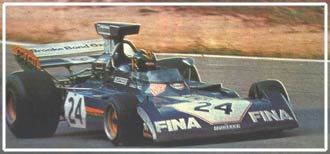 1973 An excellent drive into third place was reward for Carlos Pace aboard the square looking Surtees TS14A Cosworth. South Americans have had a great influence in Formula One, just like in the 50s it was the Argentines, and so it was in the early 70s with the Brazilians, led by the Fittipaldi brothers and Pace. Pace never quite fulfilled his early promise, and was caught out when Brabham left Cosworth for Alfa Romeo. He died in a light aircraft accident in early 1977.
1973 An excellent drive into third place was reward for Carlos Pace aboard the square looking Surtees TS14A Cosworth. South Americans have had a great influence in Formula One, just like in the 50s it was the Argentines, and so it was in the early 70s with the Brazilians, led by the Fittipaldi brothers and Pace. Pace never quite fulfilled his early promise, and was caught out when Brabham left Cosworth for Alfa Romeo. He died in a light aircraft accident in early 1977.
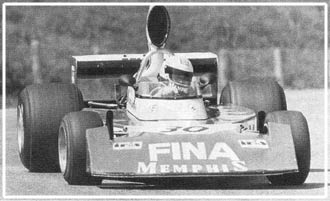 1974 A man better known for his career in sports cars, Dieter Quester on his way to ninth in the Surtees TS16 Cosworth. While perhaps not as well known as a single seat racer, Quester outqualified fellow Surtees pilots, Leo Kinnunen, Derek Bell and Jean-Pierre Jabouille by a wide margin. 'Fast John's team never quite made it as a front line team, but they got closer than some, but eventually shared the fate of most teams that tried to emulate the success of Jack Brabham and Bruce McLaren who started their own teams, closing down at the end of 1978.
1974 A man better known for his career in sports cars, Dieter Quester on his way to ninth in the Surtees TS16 Cosworth. While perhaps not as well known as a single seat racer, Quester outqualified fellow Surtees pilots, Leo Kinnunen, Derek Bell and Jean-Pierre Jabouille by a wide margin. 'Fast John's team never quite made it as a front line team, but they got closer than some, but eventually shared the fate of most teams that tried to emulate the success of Jack Brabham and Bruce McLaren who started their own teams, closing down at the end of 1978.
 1975
1975
When the winds swept across the hills around Spielberg, the Osterriechring could be a very inhospitable place. Vittorio Brambilla, 'the Monza Gorilla', demonstrates why a wet Osterriechring must be treated with respect as the mangled March-Cosworth returns to pits.
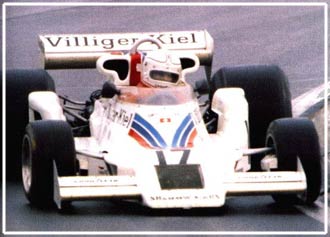 1977 It's often quoted that Jackie Oliver's Arrows team has gone the longest without winning a Grand Prix, but an Oliver run team has won a Grand Prix. 1977 saw the breakthrough win for the uncompromising Australian Alan Jones in the Shadow DN8 Cosworth. It would prove something of a false start for Jones with the Shadow not being up to scratch, and his 1978 Williams ride being one of developing the young Williams team. By 1979, Jones would be a force.
1977 It's often quoted that Jackie Oliver's Arrows team has gone the longest without winning a Grand Prix, but an Oliver run team has won a Grand Prix. 1977 saw the breakthrough win for the uncompromising Australian Alan Jones in the Shadow DN8 Cosworth. It would prove something of a false start for Jones with the Shadow not being up to scratch, and his 1978 Williams ride being one of developing the young Williams team. By 1979, Jones would be a force.
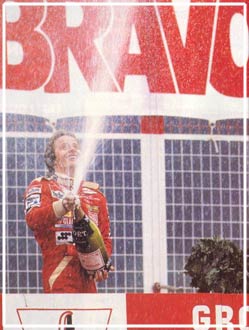 1978
1978
Gilles Villeneuve celebrates third after a relatively lonely drive to the position. SuperSwede Ronnie Peterson won his last race this day in the Lotus 79 Ford Cosworth ground effects car. There was almost a minute back to Patrick Depailler in the Tyrrell 008 Ford-Cosworth, with almost another minute further back to Villeneuve.
 1980
1980
A young Keke Rosberg steers the Fittipaldi F8 Cosworth through the ever present green of the Austrian hills. After qualifying a promising 11th, Rosberg struggled in the race before finishing the last classified finisher in 16th.
 1982 By the closest of margins, Elio de Angelis punches the air as his Lotus 91 Ford-Cosworth just gets to the line first over Keke Rosberg's Williams FW08 Ford-Cosworth. It was a race that perhaps should have fallen to Riccardo Patrese in the turbo BMW-powered Brabham although an engine failure saw to that. It would also be Colin Chapman's last win with Lotus. By 1983, the team would have to go on without arguably Formula One's shrewdest team boss/designer.
1982 By the closest of margins, Elio de Angelis punches the air as his Lotus 91 Ford-Cosworth just gets to the line first over Keke Rosberg's Williams FW08 Ford-Cosworth. It was a race that perhaps should have fallen to Riccardo Patrese in the turbo BMW-powered Brabham although an engine failure saw to that. It would also be Colin Chapman's last win with Lotus. By 1983, the team would have to go on without arguably Formula One's shrewdest team boss/designer.

1984 Future teammates Eddie Cheever (Alfa Romeo 184T) and Derek Warwick (Renault RE50) for the moment agree to differ on track position. Both cars would have engine failures, within a lap of each other.
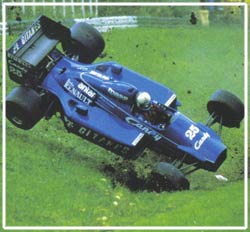
1985
When Andrea de Cesaris reported back to the pits after this image was captured, he was asked what had happenned. He reported the car had died. When Guy Ligier discovered the depth of de Cesaris' understatement he reacted very poorly. de Cesaris only raced the Ligier JS25 Renault once more before parting ways with the team.
 1986
1986
An anxious moment for Derek Warwick as his Brabham BT55 BMW 'skateboard' has a tyre deflate spectacularly. Warwick's car turned hard into the wall and was all but destroyed on Friday. Pirelli immediately withdrew their tyres from qualifying and supplied a much harder qualifier for Saturday. Warwick would not get to start though after Riccardo Patrese's car burnt to the ground after a turbo failure in practice, so Warwick was asked to give his car to Patrese after Patrese lost three gears in the race warm-up.
 1997
1997
After ten years away from the championship, the race returned in 1997 to an Osterrichring rebuilt to modern standards. The circuit was emasculated, all the big curves that were so much a part of the circuit were tightened or cut. The circuit, already one of the short ones was further shortened, and given a new name, the A-1 Ring. And this day Jarno Trulli shone. The Prost team took advantage of the pitstops and left Trulli out in the Prost JS45 Honda. He led the race for several laps, looked set for an excellent finish when the car died.
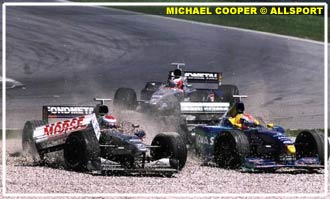 1998 Esteban Tuero (Minardi M197 Ford Cosworth) and Johnny Herbert (Sauber C17 Petronas) take to the gravel in avoidance of the out of control Tyrrell 026 of Tora Takagi, whose wing can be seen on Tuero's front right tyre. Behind them, the second Minardi of Shinji Nakano wonders if continuing down the road is a good idea.
1998 Esteban Tuero (Minardi M197 Ford Cosworth) and Johnny Herbert (Sauber C17 Petronas) take to the gravel in avoidance of the out of control Tyrrell 026 of Tora Takagi, whose wing can be seen on Tuero's front right tyre. Behind them, the second Minardi of Shinji Nakano wonders if continuing down the road is a good idea.
 1999 One of the moments of 1999. David Coulthard got Remus Kurve at the A-1 Ring completely wrong on lap one and collided with McLaren-Mercedes teammate Mika Hakkinen, spinning him around. Hakkinen would finish third behind Eddie Irvine's Ferrari and Coulthard, but the time lost having to battle back through the field surely cost the Finn victory.
1999 One of the moments of 1999. David Coulthard got Remus Kurve at the A-1 Ring completely wrong on lap one and collided with McLaren-Mercedes teammate Mika Hakkinen, spinning him around. Hakkinen would finish third behind Eddie Irvine's Ferrari and Coulthard, but the time lost having to battle back through the field surely cost the Finn victory.

















